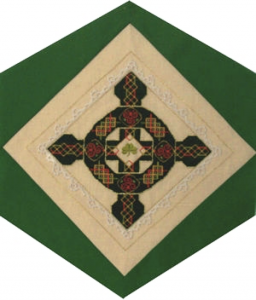Ireland

The Block
The block for Ireland was skillfully stitched by Loralyn Reilly Gazdik. Finely crocheted traditional Irish lace frames a Celtic cross. Called “poor man’s lace” and mimicking expensive European lace patterns, this crochet work is still practiced extensively today. The cross is stitched on a piece of the famous Irish linen. Its circular motif represents eternity while the four arms of the cross lead to the centre which features a shamrock, Ireland’s national symbol. The woven bars and Irish stitch, worked in customary Celtic colours, form a rich image reflecting the country’s heritage.
Cultural Profile
Ireland is called the “Emerald Isle,” as its lush landscape is said to be coloured with more than 40 shades of green. Two official languages are spoken, English and Irish Gaelic and the people are known for their dances, songs and bright costumes. Irish literature is renowned all over the world, with authors such as James Joyce, Bram Stoker, Oscar Wilde and Jonathan Swift. The capital city of Dublin is the birthplace of more Nobel literature prize winners than any other city in the world, with three native winners: W.B.Yeats, G.B. Shaw, and Samuel Beckett.
At a time when the Irish wool trade was being discouraged in order to protect the English wool trade, the production of Irish linen became a vital industry in Ireland and the highly prized linen was exported throughout the world. It’s interesting to note that today, unable to save their flax seed because of the dampness of the Irish climate, growers buy the seed from other countries, in particular, Ontario, Canada. The wool trade has also survived in Ireland. Donegal tweed, with its plain or herringbone weave, is used to make clothing such as caps, capes, skirts and jackets.
Irish lace developed into a cottage industry, particularly during the potato famine. Nuns taught the craft to many girls and women, who in turn could then earn a meager living during a difficult period in the economy. Irish linens and laces, still being handmade today, remain treasured in many Canadian homes.
Another widely practiced form of Irish culture is the country’s traditional music, featuring voice, fiddles, flutes, accordions, tenor banjos, guitars and the emblematic bodhrán drum. Spontaneous musical sessions known as céili where all able players are welcome to join in music making, are a staple of Irish life both in private and public performances. The tradition continues in Ireland and beyond, including Canada. The influence of Irish music can be found in Newfoundland’s folk music and sea songs, in the Ottawa valley fiddle playing and even on Quebec’s traditional folk music where the rhythms and instruments are unmistakably Irish.
During the 1700s, some of the Irish stonemasons who built Nova Scotia’s Fortress of Louisbourg stayed on in Canada and from the 1820s onward, Irish settlers began arriving in Canada in large numbers. In fact, at one time the Irish formed the largest non-French ethnic group in British North America. Overpopulation, destitution and disease caused massive emigration from Ireland, as did major famines and the Great Depression. Many of the Irish immigrants settled in Newfoundland, Ontario, the Maritimes and Central Canada. They were such a significant economic, social and political force that in much of Canadian society was shaped by them. Today, Irish communities can be found all across the country. Saint Patrick’s Day celebrations, to honour Ireland’s patron saint, are an important part of the Canadian cultural landscape, with Montreal’s parade said to be the oldest event of the kind in North America
Sponsor: Mona Kerr Street
